New Book Releases / November 2019
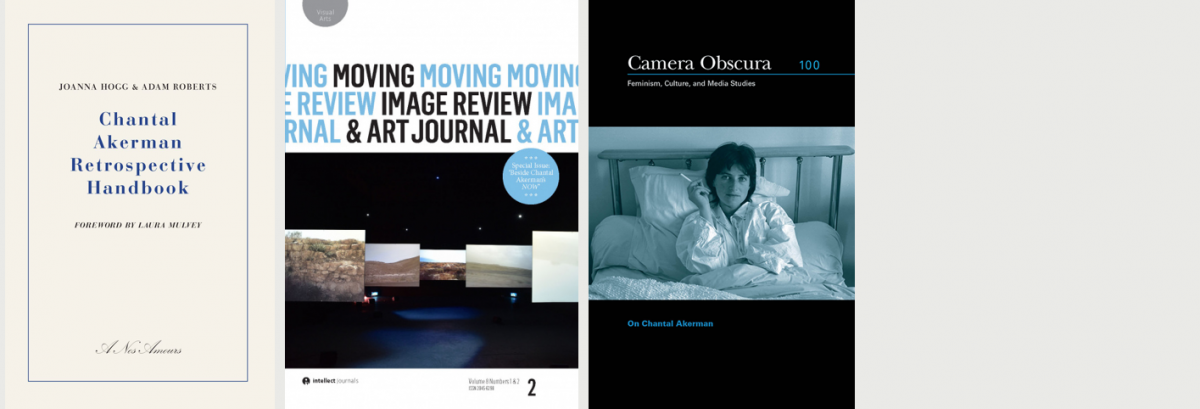 The publications on Chantal Akerman have kept on coming since our last book note before the summer. On September 24, the London programming collective A Nos Amours has published Chantal Akerman: Retrospective Handbook, a publication that gathers the research and writing that went into presenting the London Chantal Akerman retrospective. The aim is to aid future curation and programming of Akerman’s works, listing all rights and locations of print copies. The book is also “a collage of writing of many different kinds,” including texts by Raymond Bellour, Richard Brody and Ivone Margulies among others. The publication is edited by the collective’s founders, filmmaker Joanna Hogg and Adam Roberts, and includes a foreword by filmmaker and theorist Laura Mulvey. Almost sold out already, you can order this Akerman companion on the website of A Nos Amours.
The publications on Chantal Akerman have kept on coming since our last book note before the summer. On September 24, the London programming collective A Nos Amours has published Chantal Akerman: Retrospective Handbook, a publication that gathers the research and writing that went into presenting the London Chantal Akerman retrospective. The aim is to aid future curation and programming of Akerman’s works, listing all rights and locations of print copies. The book is also “a collage of writing of many different kinds,” including texts by Raymond Bellour, Richard Brody and Ivone Margulies among others. The publication is edited by the collective’s founders, filmmaker Joanna Hogg and Adam Roberts, and includes a foreword by filmmaker and theorist Laura Mulvey. Almost sold out already, you can order this Akerman companion on the website of A Nos Amours.
This book release coincided with the publication of a double edition of the Moving Image Review and Art Journal (MIRAJ) devoted to Chantal Akerman. In May, the journal Camera Obscura already dedicated a special issue to Akerman, including a rich collection of newly published photographs (e.g. a selection of photographs from the set of her abandoned American film, Hanging Out Yonkers), essays and rare interviews with Akerman’s close collaborators such as Claire Atherton, Babette Mangolte and Sonia Wieder-Atherton. MIRAJ’s special issue now features essays from eminent and emerging writers on her work, both for screen and gallery. Contributors include Dominique Païni and Janet Bergstrom, among others. You can consult the complete table of contents and purchase the issue or its separate articles on the journal’s website. Sabzian has published quite some articles on and by Chantal Akerman in the last few years, find them here or by clicking the tag below.
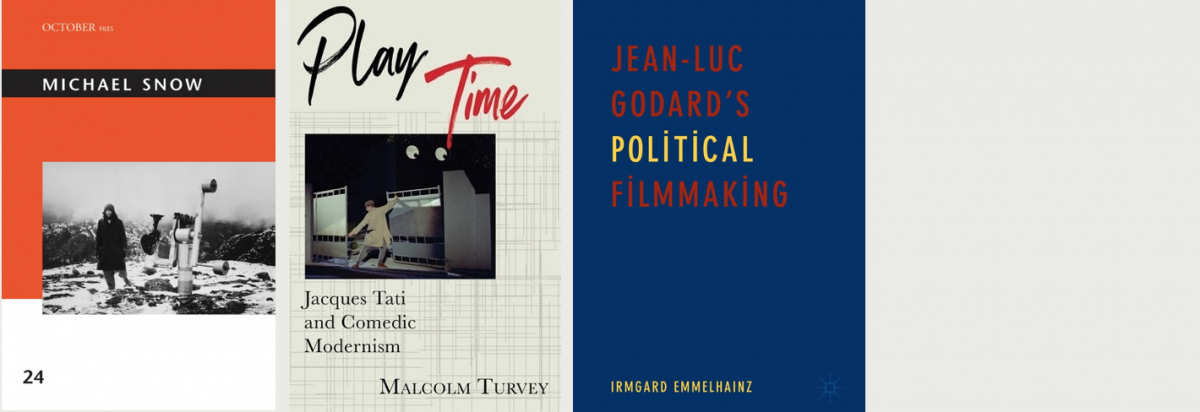 Four (plus one) recent or forthcoming publications worth mentioning are also monographic studies of auteurs, two of which were highly influential on Akerman: Michael Snow and Jean-Luc Godard. Out since November 5, Michael Snow collects essential texts on the artist’s work, with essays and interviews spanning more than four decades. The book is part of October Files, a series of inexpensive paperbacks, edited by the editors of the October journal, that address a body of work by an artist of the postwar period and traces not only the development of an important oeuvre but also the construction of the critical discourse inspired by it. From its earliest issues, October has been a primary interlocutor of Snow’s work. This volume now collects many of these texts that first appeared in its pages, such as the essay by Belgian scholar Thierry de Duve on linguistics in Snow’s work that is included alongside Snow’s response. The volume also contains other writings by Snow, images from his 1975 work Musics for Piano, Whistling, Microphone, and Tape Recorder, and an interview with the artist conducted by Annette Michelson, who co-edited the book. You can order the publication on the website of the publisher, the MIT Press.
Four (plus one) recent or forthcoming publications worth mentioning are also monographic studies of auteurs, two of which were highly influential on Akerman: Michael Snow and Jean-Luc Godard. Out since November 5, Michael Snow collects essential texts on the artist’s work, with essays and interviews spanning more than four decades. The book is part of October Files, a series of inexpensive paperbacks, edited by the editors of the October journal, that address a body of work by an artist of the postwar period and traces not only the development of an important oeuvre but also the construction of the critical discourse inspired by it. From its earliest issues, October has been a primary interlocutor of Snow’s work. This volume now collects many of these texts that first appeared in its pages, such as the essay by Belgian scholar Thierry de Duve on linguistics in Snow’s work that is included alongside Snow’s response. The volume also contains other writings by Snow, images from his 1975 work Musics for Piano, Whistling, Microphone, and Tape Recorder, and an interview with the artist conducted by Annette Michelson, who co-edited the book. You can order the publication on the website of the publisher, the MIT Press.
Malcolm Turvey, one of the current editors of October also included in the former anthology, comes with a new book of his own in December. In Play Time: Jacques Tati and Comedic Modernism, he examines Tati’s unique comedic style and evaluates its significance for the history of film and modernism. Contrary to what the title might suggest, all of Tati’s films are considered to establish how he captured elite and general audiences alike by combining a modernist aesthetic with slapstick routines, gag structures, and other established traditions of mainstream film comedy. Turvey argues that Tati’s singular and enduring achievement was to translate the democratic ideals of the postwar avant-garde into mainstream film comedy, crafting a genuinely popular modernism. David Bordwell notes that it’s at the same time “a history of avant-garde humor and a deep analysis of techniques of slapstick and satire.” Jonathan Rosenbaum remarked that “most critical books about Tati have been short on close analysis, but this one beats them all,” and he calls it the best extended critical study of Tati he has encountered. You can find the table of contents and order the book on the website of the publisher, Columbia University Press.
Released earlier this year, Jean-Luc Godard’s Political Filmmaking presents a thorough account of Godard’s investigations on the issue of aesthetic-political representation. In her study, Irmgard Emmelhainz situates Godard’s work – both his feature films and lesser known audiovisual pamphlets and essays – within the history of materialist aesthetics. Positing all of Godard’s work, from Le petit soldat (1963) to Adieu au langage (2014), as experiments in dialectial materialist filmmaking, Emmelhainz argues that Godard’s oeuvre highlights contradictions between aesthetics and politics in a quest for a dialectical image. Emmelhainz wrote her PhD on Godard and the Palestine Question, and was invited to the 2014 ‘The Fire Next Time’-programme in Ghent where she gave the opening lecture on militant cinema accompanying a screening of Ici et ailleurs (1976). Find the full video of her lecture here. You can consult the table of contents and purchase her book or separate chapters on the website of the publisher, Palgrave Macmillan.
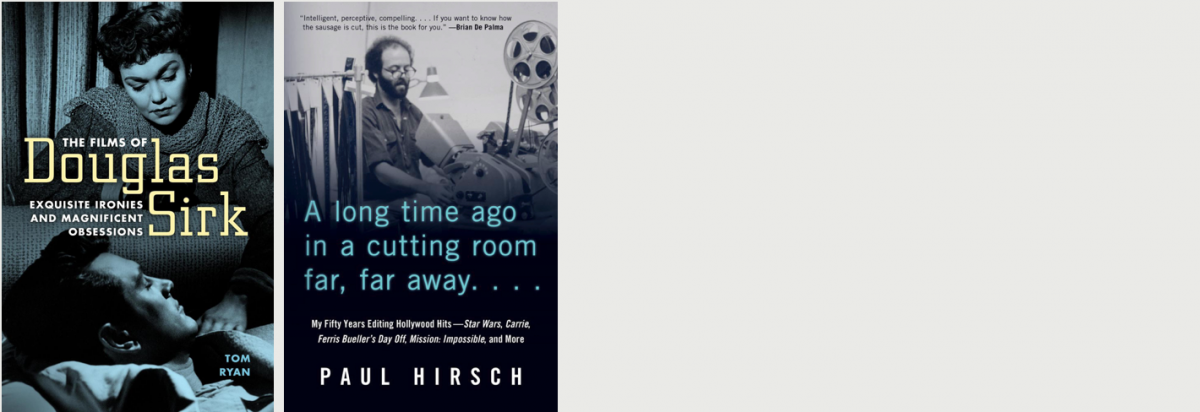 Out since May, The Films of Douglas Sirk: Exquisite Ironies and Magnificent Obsessions provides the first comprehensive critical overview of Sirk’s entire career, including his work on musicals, comedies, thrillers, war movies and westerns. Adrian Martin has called it “the definitive reference work on Douglas Sirk,” and Thomas Elsaesser also described this “labor of decades of love, deep respect, and extensive original research” as “the definitive account of Sirk’s personality and work.” You can order this book by the Australian film critic Tom Ryan on the website of the publisher, University Press of Mississippi.
Out since May, The Films of Douglas Sirk: Exquisite Ironies and Magnificent Obsessions provides the first comprehensive critical overview of Sirk’s entire career, including his work on musicals, comedies, thrillers, war movies and westerns. Adrian Martin has called it “the definitive reference work on Douglas Sirk,” and Thomas Elsaesser also described this “labor of decades of love, deep respect, and extensive original research” as “the definitive account of Sirk’s personality and work.” You can order this book by the Australian film critic Tom Ryan on the website of the publisher, University Press of Mississippi.
Published on November 5, A Long Time Ago in a Cutting Room Far, Far Away is not an auteur study, but a memoir of Paul Hirsch, the editor of a number of New Hollywood “auteurs”. Hirsch breaks down his five-decade career movie by movie. He edited the original Star Wars and Ferris Bueller’s Day Off, but his longest and most siginficant collaboration was with Brian De Palma on eleven of his films, Carrie, Obsession, Blow Out and Mission: Impossible, among them. The book opens with a story about how the decision to switch a wide shot to a close-up of the star in Obsession convinced Columbia Pictures to pick up and distribute the film. Hirsch has been scribbling notes for this book over the last 18 years. Not a how-to book, only part film school primer, part paean to legendary filmmakers and professionals, it's mainly a collection of stories and anecdotes from a veteran story teller. De Palma claims that “if you want to know how the sausage is cut, this is the book for you,” and it's available for purchase on the website of the publisher, Chicago Review Press. On Sabzian, you can read two original texts (in Dutch) on Mission: Impossible and Blow Out.
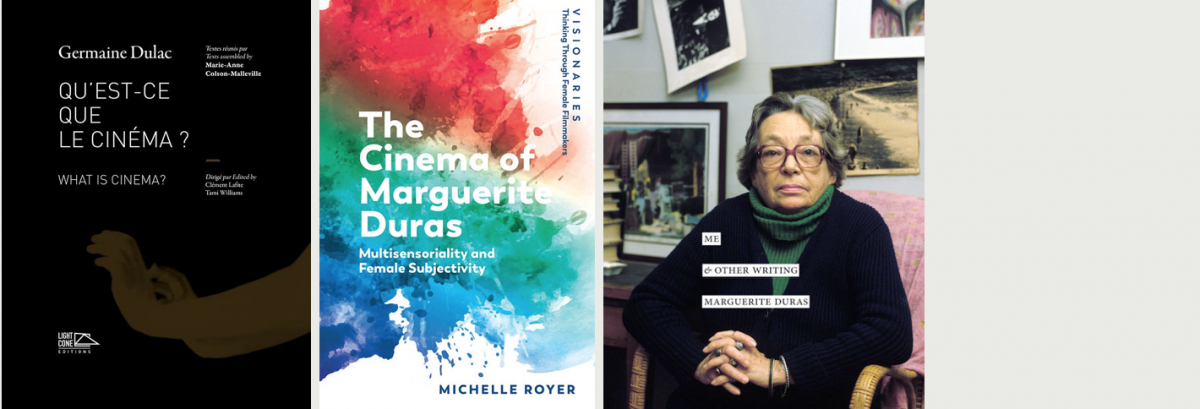 Again following up on the last, pre-summer book note, we would like to highlight nine titles that are part of a large wave of recent publications on or by women filmmakers. After Germaine Dulac’s Writings on Cinema (1919-1937) mentioned last time, now the filmmaker’s lectures (1925-1939) have been collected in the bilingual Qu’est-ce que le cinéma ? / What is Cinema? These lectures, compiled by Dulac’s partner Marie-Anne Colson-Malleville and preserved in the Light Cone archive, are published for the first time. The book illuminates the vital role of this pioneer of the 1920s French avant-garde, as an innovator of modern cinematic thought, who was reflecting, early on, in a sustained and analytical way about what cinema is. You can order the paperback or an e-book with integrated film clips on the website of the publisher, Light Cone.
Again following up on the last, pre-summer book note, we would like to highlight nine titles that are part of a large wave of recent publications on or by women filmmakers. After Germaine Dulac’s Writings on Cinema (1919-1937) mentioned last time, now the filmmaker’s lectures (1925-1939) have been collected in the bilingual Qu’est-ce que le cinéma ? / What is Cinema? These lectures, compiled by Dulac’s partner Marie-Anne Colson-Malleville and preserved in the Light Cone archive, are published for the first time. The book illuminates the vital role of this pioneer of the 1920s French avant-garde, as an innovator of modern cinematic thought, who was reflecting, early on, in a sustained and analytical way about what cinema is. You can order the paperback or an e-book with integrated film clips on the website of the publisher, Light Cone.
Edinburgh University Press has launched a whole new open access book series on female filmmakers, called ‘Visionaries’. The first publication in this collection was published in June and is dedicated to Marguerite Duras. The Cinema of Marguerite Duras explores the visual and sonic aesthetics of her films and the primacy given to voices, silence and music. In February 2020 a subsequent volume will be published on Kathleen Collins and forthcoming filmmakers in focus include Mia Hansen-Love and Joanna Hogg among others. All Visionaries books can be freely downloaded in PDF or EPUB on the website of Edinburgh University Press. Paperback and hardback are also available to purchase. On October 1, another Duras book has been published. Me & Other Writing is a new collection of Duras’s essays, translated into English for the first time. The publication wants to be a guidebook to the extraordinary breadth of Duras’s nonfiction, from the stunning one-page “Me” to the sprawling 70-page “Summer 80”. You can check the full list of included essays and order the book on the website of the small press Dorothy. You can read an excerpt in The Paris Review and The New Yorker. On Sabzian, you can read the voice-over of Duras's Les mains négatives (1978) (FR/EN/NL) and an original text (NL) on the film.
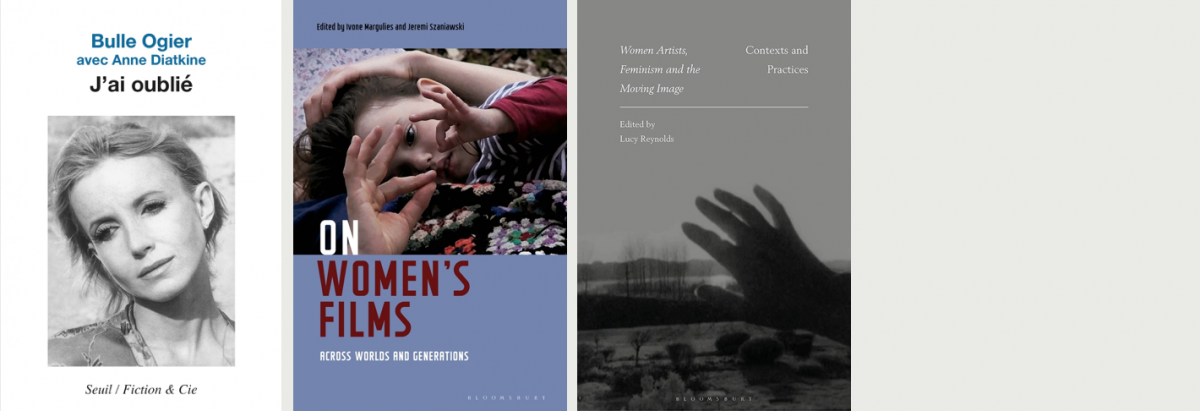 On September 19, an actress who was very close to Duras, Bulle Ogier (Le Navire Night, Agatha et les lectures illimitées, Des journées entières dans les arbres), has published her autobiography. In J’ai Oublié, co-written with Libération journalist Anne Biatkine, Ogier traces her life as an actress, woman and mother. You can purchase the book via the website of publisher, Editions du Seuil.
On September 19, an actress who was very close to Duras, Bulle Ogier (Le Navire Night, Agatha et les lectures illimitées, Des journées entières dans les arbres), has published her autobiography. In J’ai Oublié, co-written with Libération journalist Anne Biatkine, Ogier traces her life as an actress, woman and mother. You can purchase the book via the website of publisher, Editions du Seuil.
Out since July, On Women’s Films Across Worlds and Generations is a collection of essays on women auteurs with a focus on experimental and politically committed films by Claire Denis, Chick Strand and Barbara Loden, among others. The volume is edited by Brussels-born film scholar Jeremi Szaniawski together with Ivone Margulies, who contributed a new chapter on Chantal Akerman. You can find the table of contents and order the book on the website of the publisher, Bloomsbury.
In August, Women Artists, Feminism and the Moving Image: Contexts and Practices has been released by the same publisher. In this book, a diverse range of scholars, activists, archivists and artists explore the histories, practices and concerns of women making film and video across the world. Opening with a poem by the artist filmmaker Lis Rhodes, the publication includes texts by Catherine Grant, So Mayer, Erika Balsom and an interview with Basma Alsharif by Maria Palacios Cruz. You can access the full table of contents and order the book on the website of the publisher.
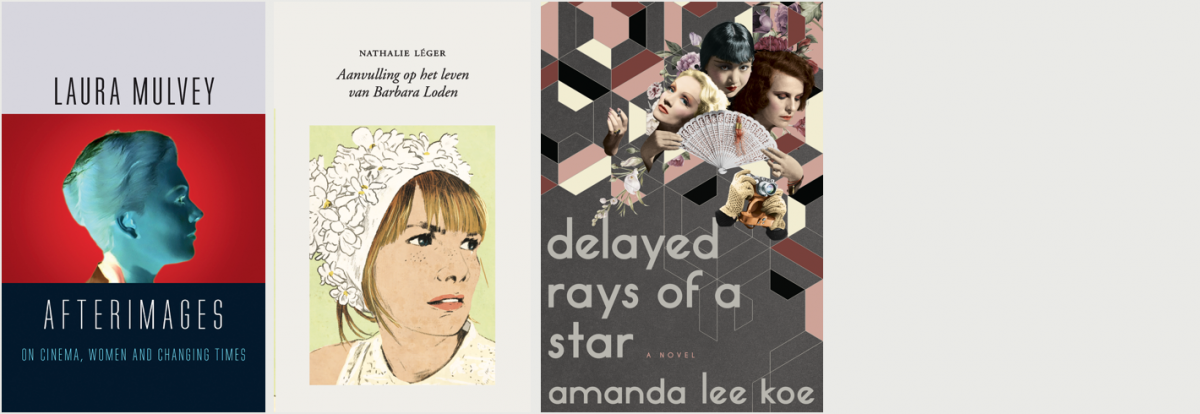 Laura Mulvey, who contributed a chapter to Margulies & Szaniawski’s collection and wrote the foreword for the latter book as well as for the Retrospective Handbook on Akerman, also comes with a new book of her own on November 14. Afterimages: On Cinema, Women and Changing Times marks a return for Mulvey to questions of film theory and feminism, as well as a reconsideration of new and old film technologies. Its title, Afterimages, alludes to the dislocation of time that runs through many of the films and works in this book, and the way we view them. This collection also ties together 14 texts on a wide array of subjects – including Max Ophüls’s Lola Montès (1955), Jean-Luc Godard’s Le Mépris (1963), Chantal Akerman’s Jeanne Dielman (1975) and moving-image art works by Morgan Fisher and Isaac Julien. Raymond Bellour describes the book as: “At once a critical fascination with Hollywood’s images of women, a nuanced approach to modern women filmmakers, and a consideration of cinema’s status in relation to contemporary art.” You can order the book on the website of the publisher, Reaktion Books.
Laura Mulvey, who contributed a chapter to Margulies & Szaniawski’s collection and wrote the foreword for the latter book as well as for the Retrospective Handbook on Akerman, also comes with a new book of her own on November 14. Afterimages: On Cinema, Women and Changing Times marks a return for Mulvey to questions of film theory and feminism, as well as a reconsideration of new and old film technologies. Its title, Afterimages, alludes to the dislocation of time that runs through many of the films and works in this book, and the way we view them. This collection also ties together 14 texts on a wide array of subjects – including Max Ophüls’s Lola Montès (1955), Jean-Luc Godard’s Le Mépris (1963), Chantal Akerman’s Jeanne Dielman (1975) and moving-image art works by Morgan Fisher and Isaac Julien. Raymond Bellour describes the book as: “At once a critical fascination with Hollywood’s images of women, a nuanced approach to modern women filmmakers, and a consideration of cinema’s status in relation to contemporary art.” You can order the book on the website of the publisher, Reaktion Books.
For our Dutch readers, we’d like to point to the Dutch translation of Nathalie Léger’s Supplément à la vie de Barbara Loden that already appeared in May. Originally published in 2012 and already translated into English in 2016 as Suite for Barbara Loden, Aanvulling op het leven van Barbara Loden moves between (auto)biography and (auto)fiction, film criticism and anecdote, film history and memoir, fact and speculation. The mysteries of Wanda (1970), the only feature film by actress and director Barbara Loden, led the author on an obsessive quest across continents, into archives, and through Pennsylvania mining towns, all to get closer to the film and its maker. You can read an excerpt and order the book on the website of the young publishing house, Koppernik.
Another well-researched book that crosses continents and blends real history with imagined narratives, and historical fact with expansive and generous storytelling, is Amanda Lee Koe’s debut novel. Published last July, Delayed Rays of a Star loosely follows the trajectories of three groundbreaking women: German actress Marlene Dietrich, the world’s first Chinese American star Anna May Wong, and filmmaker Leni Riefenstahl. At the same time, the novel weaves in questions of pop culture, authenticity in art, the terrors of war, identity, complicity, desire and difference, and is a visceral depiction of womanhood, its particular hungers, its oblique calculations, ambitions, compromises and its eventual betrayals. You can read an excerpt and order the book on the website of the publisher, Penguin Random House.
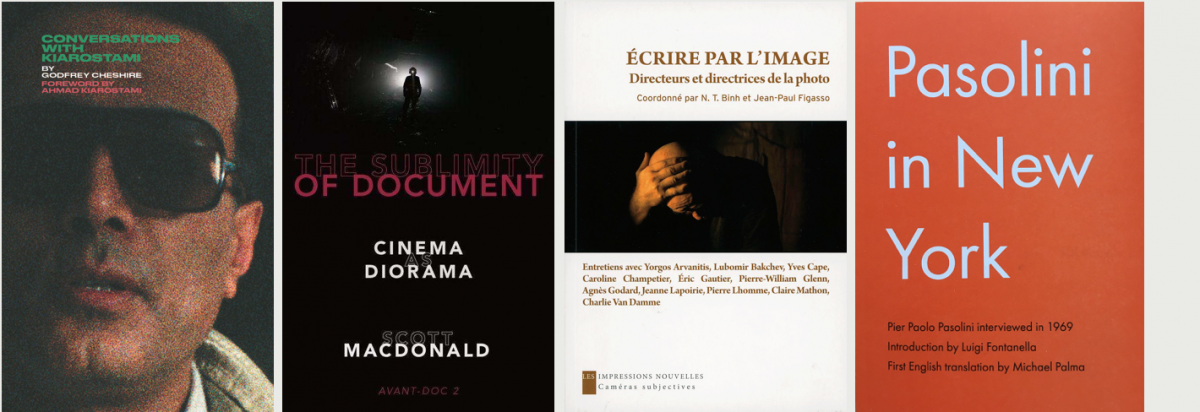 Another, smaller cluster of recent publications is made up of four interview books. Conversations with Kiarostami collects for the first time a far ranging series of interviews with the Iranian filmmaker Abbas Kiarostami by Godfrey Cheshire, one of the earliest and crucial champions of Iranian cinema in the English-speaking world. Conducted in the 1990s, these in-depth conversations offer a film-by-film account of Kiarostami’s views of his artistic development. Published last July, the book includes a foreword by Ahmad Kiarostami, the director’s son, as well as an introduction from Cheshire that contextualizes the interviews. The book is released by Woodville Press and the Film Desk and can be ordered on the latter’s website. You can read an excerpt in which Kiarostami talks about Where Is the Friend’s House? (1987) and an interview with Cheshire on the Roger Ebert website.
Another, smaller cluster of recent publications is made up of four interview books. Conversations with Kiarostami collects for the first time a far ranging series of interviews with the Iranian filmmaker Abbas Kiarostami by Godfrey Cheshire, one of the earliest and crucial champions of Iranian cinema in the English-speaking world. Conducted in the 1990s, these in-depth conversations offer a film-by-film account of Kiarostami’s views of his artistic development. Published last July, the book includes a foreword by Ahmad Kiarostami, the director’s son, as well as an introduction from Cheshire that contextualizes the interviews. The book is released by Woodville Press and the Film Desk and can be ordered on the latter’s website. You can read an excerpt in which Kiarostami talks about Where Is the Friend’s House? (1987) and an interview with Cheshire on the Roger Ebert website.
Another new collection that includes an interview with Kiarostami (from 2007 at Bard College), but has a very different scope, is The Sublimity of Document: Cinema as Diorama. Published last August, this collection is made up of 27 in-depth interviews with filmmakers and moving-image artists that explore the territory between documentary and experimental cinema. The book follows on author Scott MacDonald’s earlier Avant-Doc: Intersections of Documentary and Avant-Garde Cinema (2015). Included are, among many others, Frederick Wiseman, Bill Morrison, Ben Russell, James Benning, along with several veterans of Harvard's Sensory Ethnography Lab. Each interview is introduced by MacDonald’s overview of the filmmaker’s life and work. You can find the full list of interviewees and order the book on the website of publisher Oxford University Press.
Published last September, Écrire par l’image: Directeurs et directrices de la photo collects 11 unpublished interviews with directors of photography that originate from encounters in the film masters at the Sorbonne. Included are the late giant Pierre Lhomme (La maman et la putain, Le joli Mai), Pierre-William Glenn (Out 1, Passe ton bac d’abord), Caroline Champetier (Le pont du nord, Tout une nuit, ...), Claire Denis’ DoP Agnès Godard and Claire Mathon (Atlantique, Portrait de la jeune fille en feu), alongside two Belgians, Charlie Van Damme and Yves Cape, best known for their work with André Delvaux and Bruno Dumont respectively. You can read the introduction and find the full list of interviews at the website of the Belgian publishing house, Les Impressions Nouvelles.
Already out since April, Pasolini in New York consists of the first English translation of a 1969 in-depth interview with writer and filmmaker Pier Paolo Pasolini during his second trip to the U.S., conducted by Giuseppe Cardilo. The wide ranging conversation discusses his childhood, his move to Rome, religion, Jean-Luc Godard, Marxism and the sequence shot. This interview was unavailable to the public until it was recently discovered and rescued by Luigi Fontanella, a poet, novelist and Pasolini scholar who has written an extensive introduction for this slim volume that presents this historic interview in full. You can order the book on the website of the publisher, Film Desk Books.
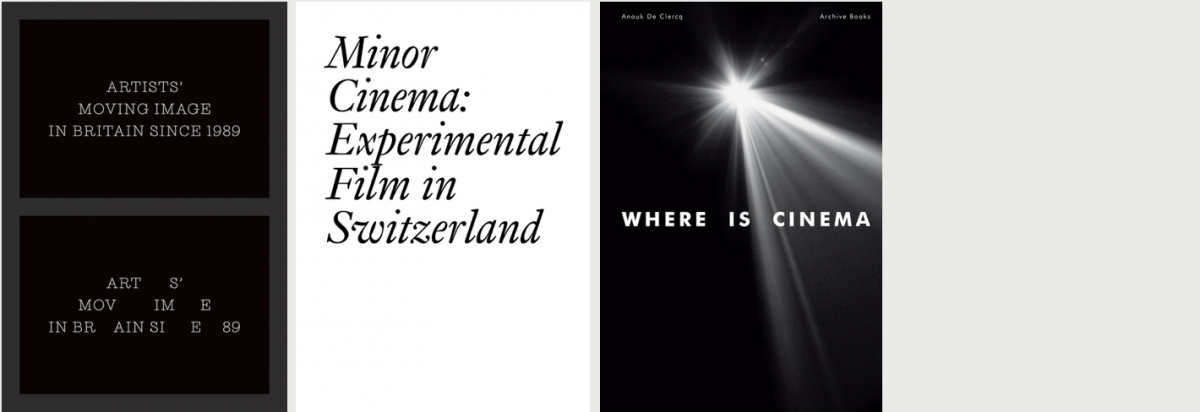 Next up are three new anthologies, two of which are dedicated to experimental and avant-garde film in the UK and Switzerland, respectively. Out since October, Artists’ Moving Image in Britain Since 1989 is an in-depth study of the expanding role of the moving image in British art over the past thirty years. You can order the book on the website of the publisher, Yale University Press. Postponed to January, Minor Cinema: Experimental Film in Switzerland proposes an active archeology of Swiss experimental cinema, making visible the main characteristics of its specific history – one which developed in parallel to the international evolution of marginal cinema, albeit fragmentary, often delayed, and with powerful personal, institutional, and geographic idiosyncrasies. It includes essays on Robert Beavers and Gregory Markopoulos, and on critic Annette Michelson. You’ll be able to order the book on the website of publisher JRP Ringier.
Next up are three new anthologies, two of which are dedicated to experimental and avant-garde film in the UK and Switzerland, respectively. Out since October, Artists’ Moving Image in Britain Since 1989 is an in-depth study of the expanding role of the moving image in British art over the past thirty years. You can order the book on the website of the publisher, Yale University Press. Postponed to January, Minor Cinema: Experimental Film in Switzerland proposes an active archeology of Swiss experimental cinema, making visible the main characteristics of its specific history – one which developed in parallel to the international evolution of marginal cinema, albeit fragmentary, often delayed, and with powerful personal, institutional, and geographic idiosyncrasies. It includes essays on Robert Beavers and Gregory Markopoulos, and on critic Annette Michelson. You’ll be able to order the book on the website of publisher JRP Ringier.
On November 15, Belgian artist, researcher and teacher Anouk De Clercq launches another anthology with a more global and contemporary scope and approached from the side of exhibition. Where is Cinema? is compiled of portraits of film initiatives from around the world, interwoven with conversations with adventurers who have rebooted movie theatres or built them up from the ground, in the hope that it can be an inspiring compendium for future cinema builders, filmmakers, film curators and film lovers. Initiator of such a project herself in 2018, Anouk De Clercq and her team launched Monokino, a nomadic film platform that strives for a permanent place in Ostend. The book contains her conversations with Verena von Stackelberg (of Wolf Kino in Berlin), Ana López Ortego & Daniel Bejarano, Ilona Jurkonytė & Ugnė Marija Andrijauskaitė, Adam Pugh, Thomas Liu & Silja Espolin Johnson, Heather Lane & Mia Ferm, and Erika Balsom, Beatrice Gibson, María Palacios Cruz & Ben Rivers (the team behind ‘The Machine That Kills Bad People’ in London). Artist and Sabzian associate Rebecca Jane Arthur took care of the editing and translations. The publication will be available on the website of the publisher, Archive Books.
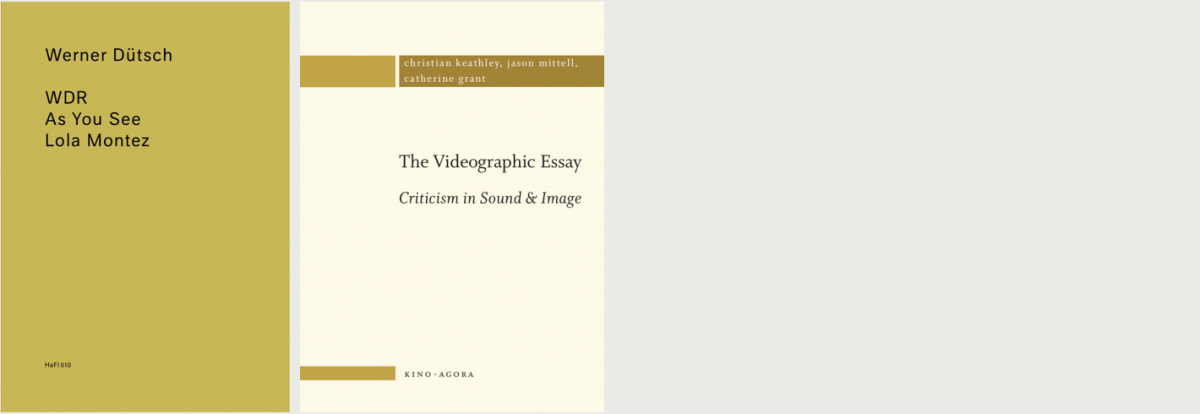 Another wave of five recent publications revolves around film criticism or critical texts. Our last but one book note of June this year featured Volker Plantenburg’s dossier on the late Werner Dütsch, commissioning editor at the West German public service broadcaster, Westdeutscher Rundfunk (WDR), who produced numerous films from Harun Farocki. Published last August, a new bilingual booklet (EN/DE) now collects three texts: an autobiographical essay by Dütsch on his work at the WDR film unit, a concise, as yet unpublished essay on Harun Farocki’s film As You See (1986), and a comprehensive review that Farocki wrote after the publication of the book Lola Montez. Eine Filmgeschichte written by Dütsch and Martina Müller. The publication also contains a selected bibliography of Dütsch’s writings and an extensive list of the films and film series he supervised at WDR. The book has been published by the Harun Farocki Institut and Motto Books; you can order it on the latter’s website.
Another wave of five recent publications revolves around film criticism or critical texts. Our last but one book note of June this year featured Volker Plantenburg’s dossier on the late Werner Dütsch, commissioning editor at the West German public service broadcaster, Westdeutscher Rundfunk (WDR), who produced numerous films from Harun Farocki. Published last August, a new bilingual booklet (EN/DE) now collects three texts: an autobiographical essay by Dütsch on his work at the WDR film unit, a concise, as yet unpublished essay on Harun Farocki’s film As You See (1986), and a comprehensive review that Farocki wrote after the publication of the book Lola Montez. Eine Filmgeschichte written by Dütsch and Martina Müller. The publication also contains a selected bibliography of Dütsch’s writings and an extensive list of the films and film series he supervised at WDR. The book has been published by the Harun Farocki Institut and Motto Books; you can order it on the latter’s website.
Werner Dütsch made it possible for filmmakers like Harun Farocki to explore essayistic formats and programmes, precursors of what today would be called ‘video essays’. In June, Canadian publishing house Caboose released a new edition of The Videographic Essay: Criticism in Sound and Image. Part how-to manual and part scholarly exploration, the book explores the aesthetics and techniques of videographic film criticism and scholarship. You can order this revised and expanded volume on the website of the publisher. A companion website to the publication features some of the work produced at the workshops that informed this book and provides online samples of the texts in the volume.
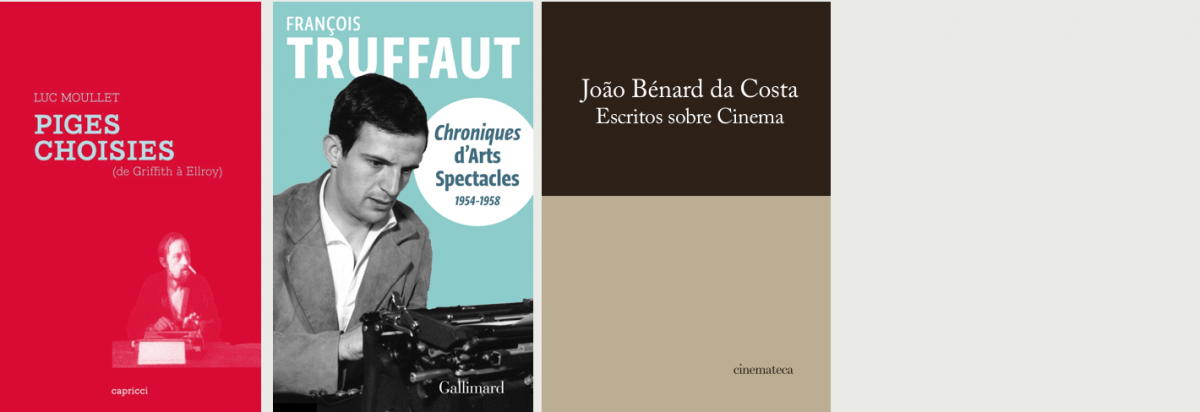 One of the other joys of the internet is the ongoing, piece-by-piece English translation of Luc Moullet’s anthology Piges Choisies: De Griffith à Ellroy (Capricci, 2009) that Bangalore based critic Srikanth Srinivasan is completing on his website, The Seventh Art. Srinivasan wrote: “I don’t think it’s hyperbole to state that it’s one of the most fascinating and unmistakeable critical works ever published: written over a period of half a century, the articles in the volume furnish one novel, unique perspective into films after another, with Luc Moullet’s caustic wit and charateristically self-deprecating humour keeping the seriousness of the analyses in balance. I’m pleased to be able to help make it available in English in its entirety and contribute to filling the enormous Moullet-shaped hole in anglophone film criticism.” Since the beginning of July, Srinivasan has translated 31 pieces, including texts from Cahiers du cinéma and Trafic, or dealing with Godard, Mizoguchi, Bresson and John Ford; you can keep up with his work via the table of contents on the website.
One of the other joys of the internet is the ongoing, piece-by-piece English translation of Luc Moullet’s anthology Piges Choisies: De Griffith à Ellroy (Capricci, 2009) that Bangalore based critic Srikanth Srinivasan is completing on his website, The Seventh Art. Srinivasan wrote: “I don’t think it’s hyperbole to state that it’s one of the most fascinating and unmistakeable critical works ever published: written over a period of half a century, the articles in the volume furnish one novel, unique perspective into films after another, with Luc Moullet’s caustic wit and charateristically self-deprecating humour keeping the seriousness of the analyses in balance. I’m pleased to be able to help make it available in English in its entirety and contribute to filling the enormous Moullet-shaped hole in anglophone film criticism.” Since the beginning of July, Srinivasan has translated 31 pieces, including texts from Cahiers du cinéma and Trafic, or dealing with Godard, Mizoguchi, Bresson and John Ford; you can keep up with his work via the table of contents on the website.
The pieces that one of Luc Moullet’s famous Cahiers colleagues (who initially disliked him), François Truffaut, wrote outside of the celebrated magazine they shared in the 50s, have now been collected in François Truffaut: Chroniques d’Arts-Spectacles (1954-1958). Already out since March, this volume gathers the texts that Truffaut wrote for Arts-Spectacles. Over the course of five years, he published more than 500 articles in this weekly, including polemical pieces against film institutions or professions (festivals, unions, producers, ...) and cinéma de papa directors, but also defenses of a new generation (Varda, Rivette, Bresson, ...) and his prefered actors and auteurs (Marilyn Monroe, James Dean, Hitchcock, Lang, Hawks, Guitry, Ophuls, Renoir, ...). In Cinema Scope, Jonathan Rosenbaum has called this collection long overdue and noted that, in the opinion of some French cinephiles, his texts for this prominent right-wing publication are superior to his reviews for Cahiers du cinéma. You can order the book on the website of the publisher, Gallimard.
In July, the second volume of the first tome of the writings of Portuguese critic, João Bénard da Costa (1935-2009), has been launched. When the six annotated volumes of Escritos sobre cinema de João Bénard da Costa will be completed, this anthology will hopefully find a French or English translator as is the case for Luc Moullet. After the first 2018 volume (1305 pages), this second one (1157 pages) brings together the texts written for the cinema sessions at the Cinemateca Portuguesa which he led for eighteen years, or for other catalogs. You can find a table of contents at the end of the excerpt available at the website of the Cinemateca.
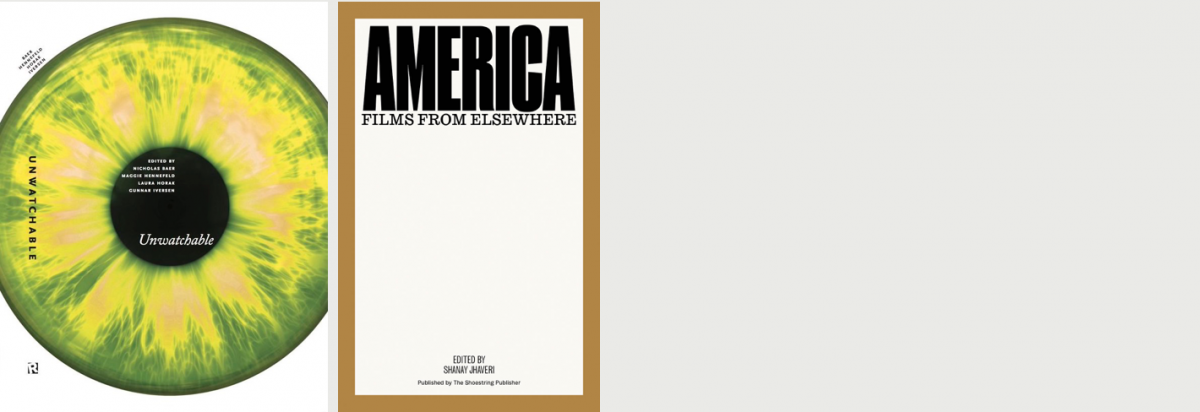 Two recently published, weighty anthologies each collect a range of contributions around one clear question. Already out since the beginning of the year, Unwatchable gathers about 60 brief essays (750-1500 words) in which one theorist, artist, critic, projectonist or curator explores what he or she finds unwatchable, whether for ethical, political, sensory, affective or physical reasons (e.g. censor bars or scratches). This volume traces what it means to proclaim something “unwatchable” – disturbing, revolting, poor, tedious, or literally inaccessible – across our contemporary media environment, on various screens and platforms. Among the contributors you can find W. J. T. Mitchell, Boris Groys, Jonathan Crary, Noël Carroll, Erika Balsom, Vivian Sobchack, B. Ruby Rich and Genevieve Yue. You can check the complete table of contents and order the book on the website of the publisher, Rutgers University Press.
Two recently published, weighty anthologies each collect a range of contributions around one clear question. Already out since the beginning of the year, Unwatchable gathers about 60 brief essays (750-1500 words) in which one theorist, artist, critic, projectonist or curator explores what he or she finds unwatchable, whether for ethical, political, sensory, affective or physical reasons (e.g. censor bars or scratches). This volume traces what it means to proclaim something “unwatchable” – disturbing, revolting, poor, tedious, or literally inaccessible – across our contemporary media environment, on various screens and platforms. Among the contributors you can find W. J. T. Mitchell, Boris Groys, Jonathan Crary, Noël Carroll, Erika Balsom, Vivian Sobchack, B. Ruby Rich and Genevieve Yue. You can check the complete table of contents and order the book on the website of the publisher, Rutgers University Press.
Published last August, America: Films from Elsewhere probes the question how films have depicted or imagined the United States from an outsider’s point of view, meaning from the perspective of filmmakers from around the world – from anyplace but America. In this 616-page volume, the visions of Chris Marker, Paul Verhoeven, Peter Watkins, Babette Mangolte, Chantal Akerman, Straub-Huillet, R.W. Fassbinder and Harun Farocki are explored by authors (about half the number of Unwatchable) such as J Hoberman and Jonathan Rosenbaum (who are in both anthologies), Nicole Brenez, James Quandt (on Jacques Demy’s Model Shop), and Adrian Martin (on Raúl Ruiz). The collection is edited by Shanay Jhaveri for the Indian The Shoestring Publisher; you can order the book on the website of Artbook.
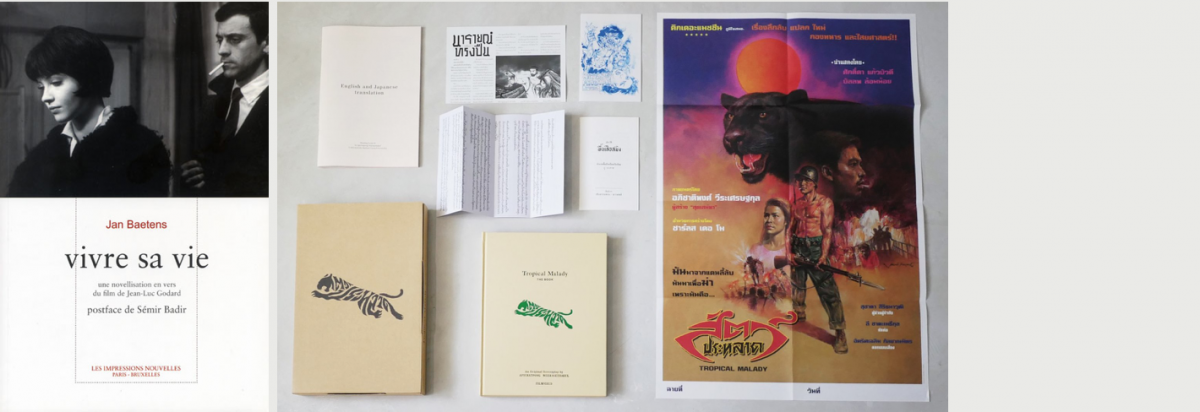 To conclude the book section, two unique projects that are each dedicated to one specific film, shouldn't go unmentioned. Last September, the novelization in verse of Jean-Luc Godard’s Vivre sa vie (1962) by the Belgian poet and scholar, Jan Baetens, has been translated into English and made available for free on the online platform ‘Place’. Originally published in 2005 as Vivre sa vie: Une novellisation en vers du film de Jean-Luc Godard, Baetens transposed into verse what the film's images evoked in him across 15 tableaux changing form for every new section.
To conclude the book section, two unique projects that are each dedicated to one specific film, shouldn't go unmentioned. Last September, the novelization in verse of Jean-Luc Godard’s Vivre sa vie (1962) by the Belgian poet and scholar, Jan Baetens, has been translated into English and made available for free on the online platform ‘Place’. Originally published in 2005 as Vivre sa vie: Une novellisation en vers du film de Jean-Luc Godard, Baetens transposed into verse what the film's images evoked in him across 15 tableaux changing form for every new section.
Also in September, the Thai group FILMVIRUS released a beautiful and carefully prepared publishing project. Tropical Malady: The Book is a deluxe facsimile of Apichatpong Weerasethakul’s shooting script for Tropical Malady (2004). The full-size reproduction includes the film’s dialogue, directions, and storyboards, all annotated by the director. In addition to the lavishly reproduced screenplay, it also features an interview with Apichatpong, a booklet of English and Japanese translations, and various documents that have been inserted between the pages, such as a handwritten letter (from Keng, one of the film’s protagonists), a Risograph print, a magazine serial and a poster. The premium edition also comes with a sticker and tote bag, both featuring the book’s calligram logo. The book is housed in a custom cardboard box with the same design. More info and the last remaining copies are available via the project’s Facebook page.
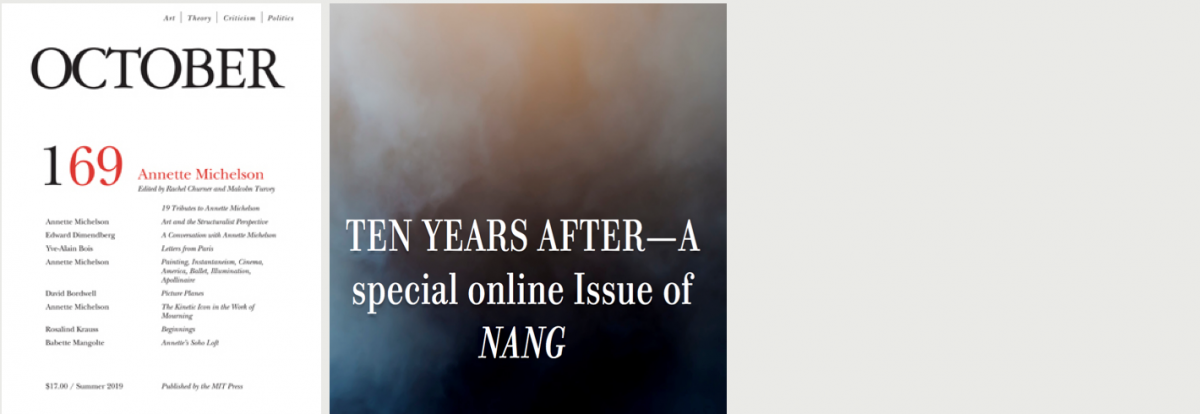 Normally, we don’t include new issues of film magazines, but over the past months some special editions have been published. First, two editions that are about critics. The summer issue of October was dedicated to Annette Michelson. Nineteen scholars, writers, and friends remember Michelson (1922–2018), who was a cofounder of this quarterly, including David Bordwell, Rosalind Krauss, Jean-Michel Frodon, Amos Gitai, Gertrud Koch, Tony Pipolo, Robert Polidori and Yvonne Rainer. The issue also includes three texts by Michelson, a conversation with her, and a series of photographs by Babette Mangolte. You can order the issue on the website of the journal or download it here.
Normally, we don’t include new issues of film magazines, but over the past months some special editions have been published. First, two editions that are about critics. The summer issue of October was dedicated to Annette Michelson. Nineteen scholars, writers, and friends remember Michelson (1922–2018), who was a cofounder of this quarterly, including David Bordwell, Rosalind Krauss, Jean-Michel Frodon, Amos Gitai, Gertrud Koch, Tony Pipolo, Robert Polidori and Yvonne Rainer. The issue also includes three texts by Michelson, a conversation with her, and a series of photographs by Babette Mangolte. You can order the issue on the website of the journal or download it here.
NANG published a special online issue in memory of the critics Alexis Tioseco and Nika Bohinc, ten years after their tragic deaths on September 1, 2009. “Both relentless advocates of neglected filmmakers and film cultures in their home countries, the Philippines and Slovenia, and also truly global citizens of cinema (...), they became icons of a romantic, young, intense cinephilia.” It includes rare texts by them, and other testimonies from their colleagues and friends. These have been connected to a “New Writing on Asian Cinema” dossier in which the editors asked younger, emerging writers (the next generation or so) to write with love about what they have watched over the last decade of Asian cinema. On Sabzian you can read a Dutch translation of Tioseco’s text on a shot in Lav Diaz’s Heremias (2006).
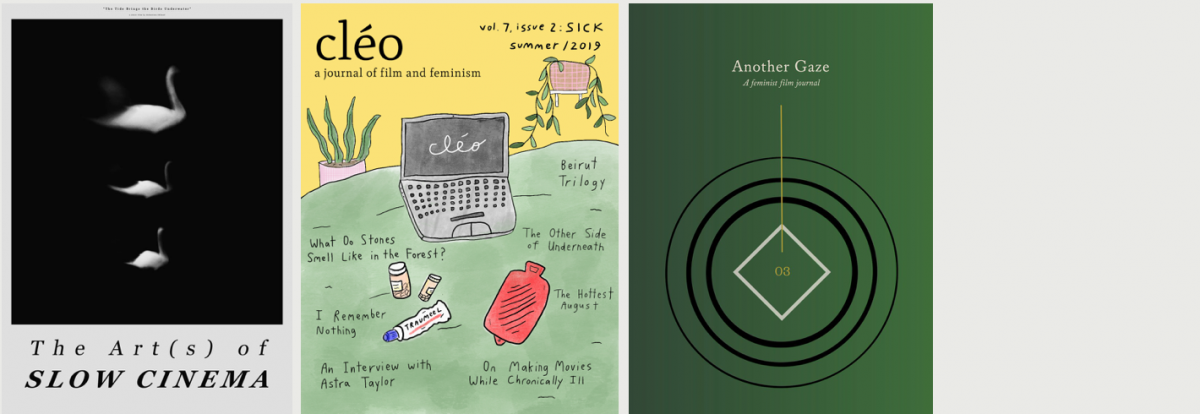 The Art(s) of Slow Cinema and cléo have released their first (digital) and final issue, respectively. After six years of blogging, The Art(s) of Slow Cinema published a first 84-page print issue earlier this year. Since September, the magazine has also been made available to order as a digital copy for 5 euro (instead of 16 euro to ship the issue on paper). You can find the table of contents on the website, and order issue 01 via paypal with a mention of your email adress. Because of funding cuts, the latest issue of cléo – a journal of film and feminism will also be the final one. Since 2013, 19 editions of cléo have appeared. The last issue is organized around the theme of sickness and includes an article on Jocelyne Saab’s Beirut trilogy among others. You can order it on their website where you can also have a look at the back issues.
The Art(s) of Slow Cinema and cléo have released their first (digital) and final issue, respectively. After six years of blogging, The Art(s) of Slow Cinema published a first 84-page print issue earlier this year. Since September, the magazine has also been made available to order as a digital copy for 5 euro (instead of 16 euro to ship the issue on paper). You can find the table of contents on the website, and order issue 01 via paypal with a mention of your email adress. Because of funding cuts, the latest issue of cléo – a journal of film and feminism will also be the final one. Since 2013, 19 editions of cléo have appeared. The last issue is organized around the theme of sickness and includes an article on Jocelyne Saab’s Beirut trilogy among others. You can order it on their website where you can also have a look at the back issues.
In August, another feminist film journal, Another Gaze, published its third issue. The hefty magazine includes essays on political militancy on screen, Ingeborg Bachmann’s Malina, Agnès Varda, Camille Billops, Ana Mendieta, Hito Steyerl, Mati Diop, Catherine Breillat, interviews with Carolee Schneemann, Barbara Hammer, and reviews of the last films by Claire Denis, Angela Schanelec and Lee Chang-Dong, among others. You can order the issue on the journal’s website.
 Senses of Cinema’s new issue marks the twentieth anniversary of the online journal and looks back at what defined the cinema of the 2010s. They’ve also compiled a dossier on Jean-Marie Straub and Danièle Huillet with a focus on their ‘utopian communism’, that looks at a broad array of their work, from their early films of the 1960s and 1970s right up to Straub’s most recent “post-Huillet” work. An extra mini-dossier revisits “some of the greatest writing from over the last 20 years of this journal”, including a text on Marguerite Duras’ adaptations of her own novels and one on the politics of space and representation in Chantal Akerman’s cinema. In November, Umbra will launch its tenth issue, which is called ‘Madness’ and has an image of Akerman’s Jeanne Dielman (1975) on its cover. Umbra is a quarterly newspaper on screen culture published by Lightcube, a film collective based in New Delhi, India, who organise screenings and festivals, publications, workshops and work on cinema outreach. You will be able to order the issue on their website.
Senses of Cinema’s new issue marks the twentieth anniversary of the online journal and looks back at what defined the cinema of the 2010s. They’ve also compiled a dossier on Jean-Marie Straub and Danièle Huillet with a focus on their ‘utopian communism’, that looks at a broad array of their work, from their early films of the 1960s and 1970s right up to Straub’s most recent “post-Huillet” work. An extra mini-dossier revisits “some of the greatest writing from over the last 20 years of this journal”, including a text on Marguerite Duras’ adaptations of her own novels and one on the politics of space and representation in Chantal Akerman’s cinema. In November, Umbra will launch its tenth issue, which is called ‘Madness’ and has an image of Akerman’s Jeanne Dielman (1975) on its cover. Umbra is a quarterly newspaper on screen culture published by Lightcube, a film collective based in New Delhi, India, who organise screenings and festivals, publications, workshops and work on cinema outreach. You will be able to order the issue on their website.
 In July, nY – tijdschrift voor literatuur, kritiek & amusement has published an issue on film and literature as a double practice (in Dutch). Sabzian has published the Dutch translation of Charles Bernstein’s interview with filmmaker and poet Abigail Child from this issue (‘Tijdshoeken’) and the original interview in English (‘Time Corners’). The magazine also includes Child’s essay ‘Digital wreaking’ about recent digital work, a selection from the book LENS (1964) by the filmmaker and poet Frank Kuenstler, poetry by Bruce Andrews and Veva Leye, filmmaker Els van Riel’s essay ‘Buchstabe’ about her recent film work, Jan Op de Beeck’s exploratory essay ‘Materiality, fragment, montage’, an introduction by Martin Grennberger to filmmaker Peter Gidal and his film Assumption (1997), and artistic work by Jelena Vanoverbeek and Joris De Rycke. The website of the magazine is under construction but you can find the table of contents on their Facebook page and still buy the issue in specialized bookstores.
In July, nY – tijdschrift voor literatuur, kritiek & amusement has published an issue on film and literature as a double practice (in Dutch). Sabzian has published the Dutch translation of Charles Bernstein’s interview with filmmaker and poet Abigail Child from this issue (‘Tijdshoeken’) and the original interview in English (‘Time Corners’). The magazine also includes Child’s essay ‘Digital wreaking’ about recent digital work, a selection from the book LENS (1964) by the filmmaker and poet Frank Kuenstler, poetry by Bruce Andrews and Veva Leye, filmmaker Els van Riel’s essay ‘Buchstabe’ about her recent film work, Jan Op de Beeck’s exploratory essay ‘Materiality, fragment, montage’, an introduction by Martin Grennberger to filmmaker Peter Gidal and his film Assumption (1997), and artistic work by Jelena Vanoverbeek and Joris De Rycke. The website of the magazine is under construction but you can find the table of contents on their Facebook page and still buy the issue in specialized bookstores.
The legendary journal Jump Cut, that evolved from a print to an online pubication in 2001, has a new archival home with a searchable database. On this archive website their back catalogue is available for reading online and downloading, from the foundational 1974 issue to number 58. The current issue 59 of Fall 2019 is accessible on the journal’s regular website.
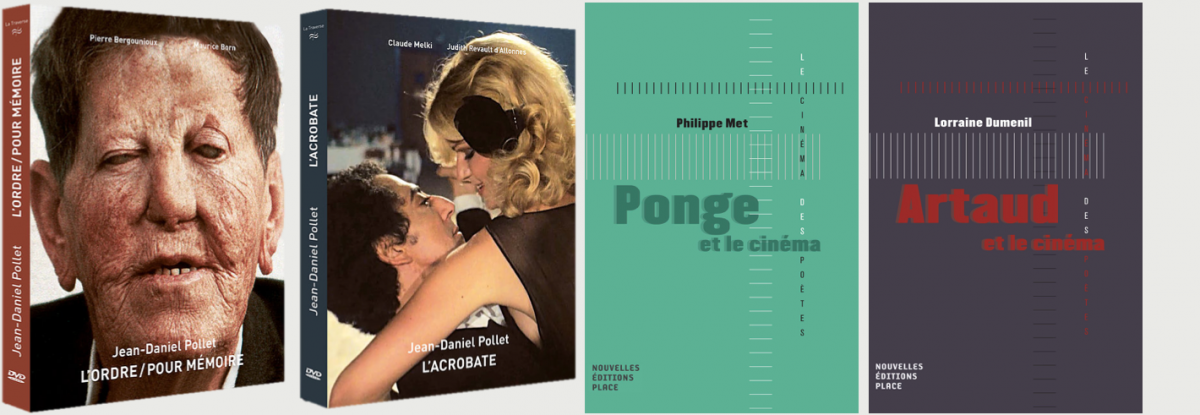 Normally, we also don’t include DVD releases, but some distinctive and substantial ’livres-DVD’ (DVD books) are forthcoming or have recently been released. After Méditerranée (1963) and Bassae (1964) (see note), Les Éditions de l'Oeil and La Traverse have released five new livres-DVD in June, two of which are dedicated to restorations of the work of Jean-Daniel Pollet. One collects Pollet’s L’Ordre (1974, 42’), Pour Mémoire (La Forge) (1978, 61’) and Les Morutiers (1968, 20’) and contains a 112 page booklet with texts, working documents and preparation photographs. A second DVD presents Pollet’s L’Acrobate (1976, 97’) together with a 96 page publication. English and Spanish subtitles are available on all DVDs. You can find and order the other three DVD books on the website of Les Éditions de l'Oeil, including the lesser known but fascinating Simone Barbès ou la vertu (Marie-Claude Treilhou, 1980), and Beau temps mais orageux en fin de journée (Gérard Frot-Coutaz, 1986) for which they transcribed a discussion between the filmmaker and Serge Daney. On Sabzian, you can read Boris Lehman’s 2004 text on Jean-Daniel Pollet (FR/NL). On a related note, Nouvelles Editions Place have published two new books in their series ‘Le cinéma des poètes’, one of which is dedicated to a poet very dear to Pollet: Francis Ponge (Le parti pris des choses, 1942; Namens de Dingen). Méditerranée and especially Dieu sait quoi (1994) share the sensibility of Ponge’s poetry of things and thingness (which was also close to Robert Bresson and the Godard of Two or Three Things I Know about Her). The other book in the series, also published last October, is on Artaud et le cinéma. You can order the books in this collection on the website of the publisher.
Normally, we also don’t include DVD releases, but some distinctive and substantial ’livres-DVD’ (DVD books) are forthcoming or have recently been released. After Méditerranée (1963) and Bassae (1964) (see note), Les Éditions de l'Oeil and La Traverse have released five new livres-DVD in June, two of which are dedicated to restorations of the work of Jean-Daniel Pollet. One collects Pollet’s L’Ordre (1974, 42’), Pour Mémoire (La Forge) (1978, 61’) and Les Morutiers (1968, 20’) and contains a 112 page booklet with texts, working documents and preparation photographs. A second DVD presents Pollet’s L’Acrobate (1976, 97’) together with a 96 page publication. English and Spanish subtitles are available on all DVDs. You can find and order the other three DVD books on the website of Les Éditions de l'Oeil, including the lesser known but fascinating Simone Barbès ou la vertu (Marie-Claude Treilhou, 1980), and Beau temps mais orageux en fin de journée (Gérard Frot-Coutaz, 1986) for which they transcribed a discussion between the filmmaker and Serge Daney. On Sabzian, you can read Boris Lehman’s 2004 text on Jean-Daniel Pollet (FR/NL). On a related note, Nouvelles Editions Place have published two new books in their series ‘Le cinéma des poètes’, one of which is dedicated to a poet very dear to Pollet: Francis Ponge (Le parti pris des choses, 1942; Namens de Dingen). Méditerranée and especially Dieu sait quoi (1994) share the sensibility of Ponge’s poetry of things and thingness (which was also close to Robert Bresson and the Godard of Two or Three Things I Know about Her). The other book in the series, also published last October, is on Artaud et le cinéma. You can order the books in this collection on the website of the publisher.
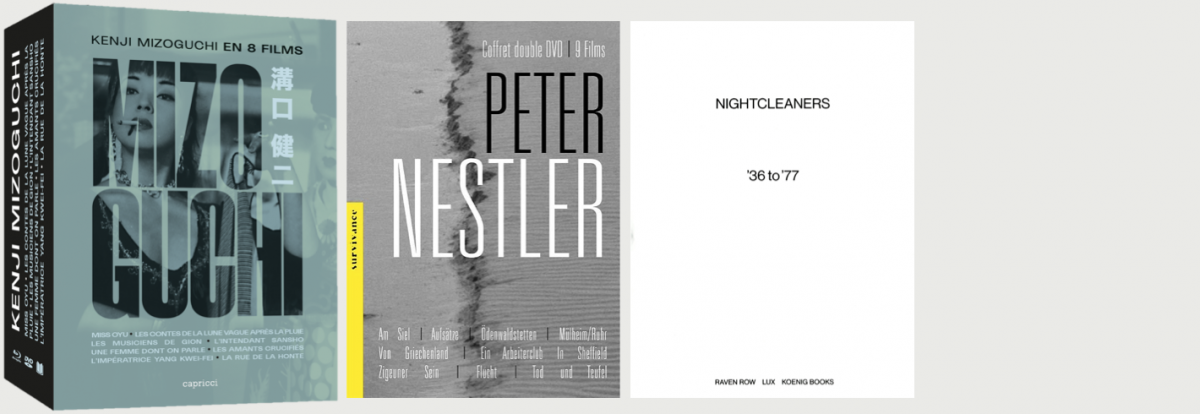 On January 7, Survivance releases a Peter Nestler DVD box set with nine of his films and a 44 page booklet. The films will have French and English subtitles. The box is already available for pre-order on the website of the distributor Arcadès. On November 5, also a Kenzi Mizoguchi blu-ray/DVD box set came out. It includes eight of his films; three are 4K restorations and the others remastered in 2K. The box contains a specially compiled 128 page book, including texts by Mizoguchi, critics, an interview with his collaborators and numerous photographs. Booklet and subtitles are in French only. You can read an excerpt and order the box set on the website of the publisher, Capricci.
On January 7, Survivance releases a Peter Nestler DVD box set with nine of his films and a 44 page booklet. The films will have French and English subtitles. The box is already available for pre-order on the website of the distributor Arcadès. On November 5, also a Kenzi Mizoguchi blu-ray/DVD box set came out. It includes eight of his films; three are 4K restorations and the others remastered in 2K. The box contains a specially compiled 128 page book, including texts by Mizoguchi, critics, an interview with his collaborators and numerous photographs. Booklet and subtitles are in French only. You can read an excerpt and order the box set on the website of the publisher, Capricci.
In May, the Berwick Street Film Collective’s Nightcleaners (1975) and its companion film ’36 to ’77 (1978) have been digitally released for the first time in a special box set containing two discs (DVD or blu-ray) and two publications: a 148 page book and a 84 page booklet-zine featuring facsimiles of the original political campaign newsletters, magazines, film transcriptions and other material. The first book contains four commissioned essays, plus a new interview with Collective member Mary Kelly, excerpts of interviews with member Marc Karlin and from James Scott’s 1972 Nightcleaners production diary. The other booklet includes newsletters of the Cleaners Actions Group (1971), pages from Red Rag (1973) and Spare Rib (1975), a 1977 transcript of Nightcleaners, and an issue of Shrew (1971), the publication of the Women’s Liberation Workshop (this specific Shrew issue is designed by Mary Kelly and dedicated to the cleaners’ struggle). Laura Mulvey ascribed “these two essential films, a central, even mythic, place in the 1970s juncture between radical politics and radical aesthetics.” You can order the DVD edition on the website of Koenig Books, who published this box set in partnership with LUX and Raven Row. The exclusive blu-ray edition is only available directly from the website of LUX.
You can find an overview of all the ‘New Book Releases’ Notes here.

